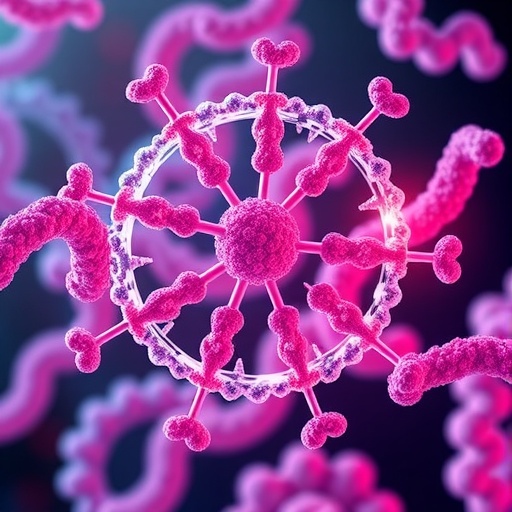In a groundbreaking advance poised to revolutionize targeted medicine, researchers at the University of Washington have devised an innovative approach that empowers therapeutic proteins to autonomously determine their precise sites of action within the human body. Unlike conventional treatments that distribute medicinal compounds broadly—often inducing harmful off-target effects—these engineered proteins utilize logical decision-making frameworks embedded in their molecular tails to recognize complex combinations of biological markers. This intelligent targeting can enhance drug efficacy and safety, offering unprecedented control over therapeutic delivery.
The principle underlying this development lies in the design of protein tails that self-assemble into specific shapes, enabling them to respond dynamically to unique constellations of biochemical signals, or biomarkers, present in certain tissues. Unlike single-biomarker targeting, which risks nonspecific interactions due to shared markers across multiple regions, this multidimensional recognition strategy leverages Boolean logic—famously used in computing—to activate the therapeutic payload only when a precise set of environmental cues co-occur. This selective mechanism promises to confine therapeutic action strictly to pathological sites, minimizing collateral damage.
Earlier iterations of such logic-driven biomaterials required laborious manual synthesis via organic chemistry, which limited scalability and throughput. However, recent advances in synthetic biology have transformed protein engineering, allowing the rapid and high-fidelity production of complex logic-tailored proteins by programming living cells as efficient biomanufacturing factories. By rewriting DNA blueprints and harnessing biological machinery, researchers can now manufacture these sophisticated constructs in a matter of weeks rather than months, greatly accelerating the path from design to practical application.
Central to this innovation is the ability to integrate multiple logical gates—fundamental operations such as AND, OR, and combinations thereof—directly within the protein architecture. These molecular logic gates determine the spatial and temporal activation of the therapeutic, responding to up to five different biomarkers simultaneously. This level of complexity ensures that only when all designated markers coincide does the protein exert its effect, refining targeting granularity to a level previously unattainable. By deploying these programmable proteins onto various carriers including hydrogels, microspheres, or even living cells, the delivery system gains extraordinary versatility for diverse clinical contexts.
The implications for cancer therapy are particularly compelling. Tumors often present intricate biomarker landscapes that differ subtly from healthy tissue. The capacity to recognize intersecting biomarker patterns means treatments can be precisely channeled to malignant cells while sparing normal ones, reducing systemic toxicity and improving patient outcomes. Furthermore, this strategy holds promise beyond oncology, potentially transforming therapies for autoimmune diseases, infections, and regenerative medicine by fine-tuning intervention sites with molecular precision.
Development of these autonomously logical proteins required surmounting significant bioengineering challenges. Researchers exploited novel protein bonding techniques that enable permanent linkages between distinct protein elements, fostering complex tertiary structures capable of nuanced environmental sensing. These molecular topologies translate conventional digital logic models into three-dimensional biochemical circuits, inaugurating a new class of biologically integrated computational therapeutics that function within living systems.
Beyond therapeutic delivery, the platform’s modularity enables concurrent deployment of multiple proteins responsive to differing logical conditions, facilitating sophisticated multi-drug regimens controlled at microenvironments within the body. This modular design could, for instance, orchestrate sequential or synergistic drug release schedules, adapting dynamically to evolving disease states. Additionally, the sensitivity to biomarker combinations opens doors to real-time diagnostic applications, such as blood assays that manifest colorimetric changes only upon complex biochemical signatures, enhancing disease detection accuracy.
As this technology matures, scaling to larger and more intricate logical circuits embedded within proteins is anticipated to further elevate specificity and functional complexity. The researchers envision crafting biomaterials capable of recognizing highly precise cellular neighborhoods, potentially down to individual cells. Achieving this level of intracellular or tissue-level targeting could redefine personalized medicine, enabling interventions that operate entirely autonomously with exquisite spatial resolution.
Ongoing efforts are focused on expanding the catalog of identifiable biomarkers and refining the breadth of programmable responses. Collaborative ventures with other laboratories and clinical partners aim to translate these proof-of-concept demonstrations into viable treatments, encompassing comprehensive preclinical validation and eventual human trials. The adaptability of this approach to diverse disease contexts underscores its transformative potential in biomedical science.
In summary, this pioneering research introduces a paradigm shift by merging computational logic with molecular biology to create smart, precise, and scalable therapeutic entities. By integrating Boolean logic into protein engineering, the study lays foundational groundwork for a new generation of treatments that intelligently navigate the body’s complex biochemical landscape, thereby advancing the frontier of precision medicine.
Subject of Research: Targeted drug delivery using protein-based Boolean logic circuits for biomarker-guided therapeutics.
Article Title: Boolean Logic-gated Protein Presentation via Autonomously Compiled Molecular Topology
News Publication Date: October 9, 2025
Web References: http://dx.doi.org/10.1038/s41589-025-02037-5
Image Credits: DeForest et al./Nature Chemical Biology
Keywords: Targeted drug delivery, Boolean logic, protein engineering, synthetic biology, biomarker recognition, molecular topology, therapeutic specificity, programmable biomaterials, cancer therapy, precision medicine




